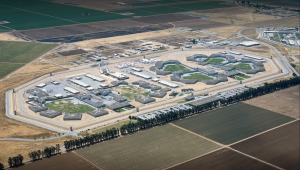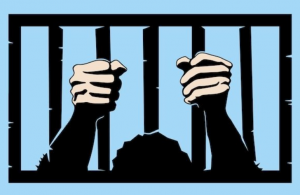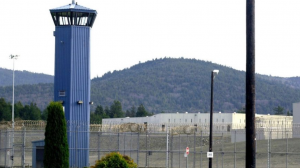“Everyone is human.” These words were our introduction to Salinas Valley State Prison (pictured below) and came as a bit of a shock to me. I knew that the sentiment was true, and I strongly agree with the meaning behind it, that everyone is deserving of dignity, but I did not expect this to be so explicit by a Lieutenant about to give us a tour of the prison he’d worked at for over a decade. This clearly reflected a bias I had of what someone working in a prison thinks of those occupying cells, and a bias I was quite pleased to check. This also made me hyper aware of how this tour could be very biased if we didn’t get a chance to talk with any inmates and only heard the Correctional Officer (CO) perspectives. This was reminded to us by two inmates in different yards, who both made it clear that “if you want to know what really goes on here, talk to us, not the Cos.” Hearing this, I understood that there was truth in these words, and that we were hearing a different reality from the CO’s perspective. However, we had to keep in mind two important points: first, one CO or prisoner’s perspective will not encompass all the views of each CO or prisoner, respectively; and second, since we are there to learn, each “side” will have a bias in wanting us to take something away. COs are likely not going to want to leave us with a bad impression of how inmates are treated, and inmates are likely looking to tell their story of how the system has wronged them. Both have the potential to be true, but not everyone in prison is treated well, and not everyone in prison is innocent. 
The dynamics in the prison yards were fascinating, and very different depending on which yard people were at. The lowest level of security was in a Special Needs Yard (SNY) for those who would be at risk of being killed in the general population yards—includes child molesters, those who’ve dropped out of gangs, gay men, and anyone else who wouldn’t survive in the gang-centric yards. This yard was also unique because to get in all it takes is a request from prisoners, and they cannot be denied. At the same time, they can’t return to general population yards unless they were sent by a gang as a “sleeper” to kill someone, in which case they would be welcomed back to their gang in the other yards. SNY still had gang dynamics, but they weren’t divisions along racial and regional lines, as is the norm in prisons. The other yards were populated on a point system, with high points meaning more secure. A stark difference to the loud, energetic, coexistent SNY, the other yards were completely self-segregated by gang and race, with each having their own turf. These gang members would spend much of their time in the yard just staring at each other, ready for whatever could pop off. They also focused on discipline through exercise drills, which also served to keep these “soldiers” battle ready at all times. Their reality is always being surrounded by danger and living in fear; not an ideal environment to change in.

Although we were able to walk through an SNY and general population yard, I didn’t ever feel in danger or afraid. This didn’t have anything to do with “being tough,” but instead was reflective of the power we had in being visitors—the riflemen stationed in towers with various vantage points in the yards were the ultimate protection for us, not to mention the numerous COs with batons, mace, etc. that stayed near us. Power was a very strange concept in prison, especially since a common narrative among COs was that the prisoners ran the prison, and they were “just there,” often referencing the difference in numbers and the viciousness of the gangs. A seemingly fair point when you learn that these gangs get all kinds of drugs and other contraband in despite this being a maximum-security prison, and the fact that weapons were made from anything, and guards were quick to share that they knew about half of the members of some gangs will always have a weapon on them, despite searches and metal detector wands. However, it sounded completely hypocritical to me, considering there were always officers in towers with guns fixed on the yards, and they controlled when the doors to cells open, when they eat, and everything else that routinized the inmate’s life there. While I am more understanding of why guards say that inmates run everything after hearing of the intensity of the gangs, I cannot accept the disregard of power that it takes to make that statement true.
Diving a bit deeper into the gangs, we learned from Julie Reynolds Martinez—an investigative journalist whose knowledge of the system is invaluable—about the history of the 4 main gangs that originated in California prisons, and have now been spread all over the country and bled into communities outside of the prison. There is the Aryan Brotherhood, who have a reputation of being the most ruthless and violent, mostly because they are the smallest of the main gangs—not a surprise given the demographics of the Salinas Valley and the propensity of the criminal justice system to prosecute people of color at absurd rates compared to whites. For Latinos there are two options, the Mexican Mafia, which is historically associated with southern California prisons, and the Nuestra Familia, with origins in northern California prisons. This split between Norteños (northern CA) and Sureños (southern CA) came with perceptions of the former as having been in the US for a few generations and supportive of the Cesar Chavez and the UFW (United Farm Workers), and the latter being first generation or immigrants from Mexico or other Central and South American countries themselves. Nowadays these divisions are much less clear, though when entering prison, you will be assigned a gang if you aren’t in one already, and that will be based on your race and where you’re from. Finally, there’s the Black Guerrilla Family, which stemmed from the Black Panther Party and was very political at its origin, which has now split into Bloods and Crips. The Bloods and Crips have different turf in the yards, but will help each other if one is attacked, unlike the Latino gangs, which perhaps relates to black solidarity carrying over from the Black Panther Party influence. There is another gang in general population, mostly made up of Asians, but will occasionally accept members who may not fit the other categories. The one thing that connects all these gangs in the yard is business; money, in this case, doesn’t see race.

These gangs developed connections on the outside when members started to get released and continue the business and gang life outside the prison walls, along with using women to carry messages, drugs, etc. These gangs originated in the notorious Pelican Bay State Prison (pictured above), and it was because of an attempted solution that they ended up spreading. To address the growing power of these prisons, the now famous Robert Muller—who then worked in the office of the U.S. Attorney in San Francisco—decided to charge the leaders of the gangs with federal crimes so he could move them to Colorado, far from their gang in California. They didn’t account for the potential for this to then spread the gangs through the federal system, gaining them national prominence. This also underestimated the sophistication of the politics in these gangs, who had constitutions that said the leadership needed to be in Pelican Bay, leading to a battle for the top among the generals. Needless to say, new leadership formed, and the gangs remain.
While this history is fascinating, it doesn’t speak to why the gangs started. Was it in response to the conditions they faced in prison and a desire to form an identity, community, sense of safety, and revenue source in that environment? Perhaps, and perhaps prisons became more controlling in response to these gangs and the violence that they brought. I think the answer involves both these notions, but this begs the question of what to do now. Is it wise to split up the prisoners based on their points so that the gangs are practically forced together? Does keeping them in this environment really provide a chance for rehabilitation? These were the thoughts bouncing around my head at the end of our time in Salinas Valley State Prison. In the end, those behind the bars are just as human as those controlling when those bars open and close. It’s important to be held accountable for one’s actions, but we are all human, and that means we must critically examine what “rehabilitation” actually means and what kind of justice is best—retributive or restorative.

